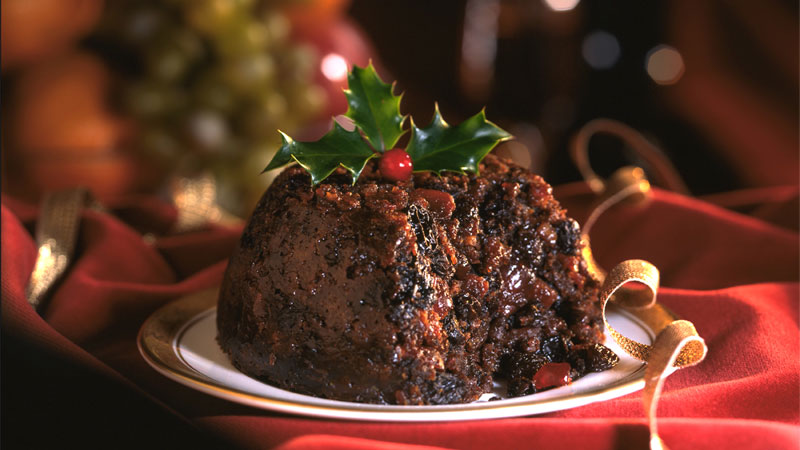No British Christmas feast is complete without its pudding. Soaked in tradition, symbolism, and enough booze to float a battleship, the pudding holds deep-rooted cultural, historical, and religious significance for any Christmas-loving Brit.
Some form of the dish has featured on Britain’s dining tables every Dec. 25 since medieval times. In keeping with the nation’s reputation as a booze-loving isle, the dessert includes alcohol at every stage of its preparation and serving.
In the States, the Christmas pudding is perhaps most notable for its inclusion as “figgy pudding” in the famous Christmas carol, “We Wish You a Merry Christmas.” Literary buffs might recall its cameo in “A Christmas Carol” by Charles Dickens. Past these references, though, the dish is an Anglo quirk that didn’t quite make its way across the Atlantic — much like Christmas crackers, paper crowns, and Boxing Day.
Christmas pudding first started resembling its modern-day guise in the Victorian era, when Dickens described it and its typical serving ritual in “A Christmas Carol”: “A speckled cannon-ball, so hard and firm, blazing in half of half-a-quarter of ignited brandy, and bedight with Christmas holly stuck into the top.” Though published in 1843, those same words could easily be used to describe the dessert today.
The “speckled cannon-ball” traditionally contains a mix of 13 ingredients, symbolizing Jesus and the 12 apostles. These can include dried fruit, nuts, flour, breadcrumbs, sugar, spices, eggs, alcohol, and suet, a raw beef or mutton fat.
Also referred to as plum or figgy pudding, Christmas pudding doesn’t typically contain either of these fruits (although dried plums, or prunes, are used). The word “plum” was used as a historic catch-all for any dried fruit. Figgy or “fygey” pudding, meanwhile, was a 15th-century precursor to plum or Christmas pudding.
Christmas pudding holds historical importance as well. Many ingredients are sourced from around the globe, symbolizing the British Empire. This understandably leaves a bad taste for some. In the 1836 “Book of Christmas,” Scottish-born poet and author Thomas Kibble Hervey described it as “a truly national dish,” while also noting its less-than-favorable reputation with international diners. “A Frenchman will dress like an Englishman, swear like an Englishman, and get drunk like an Englishman; but if you would offend him for ever [sic], compel him to eat plum-pudding,” he wrote.
Preparing the pudding is a family affair. It takes place five weeks before Christmas, on the last Sunday before Advent, known as “Stir-up Sunday.” On that day, each family member makes a silent wish while they stir the pudding from east to west in honor of the journey of the Wise Men. Various metal trinkets may also be included at this time to bring further luck. The mix is then placed inside a greased pudding mold, steamed on the stove for a number of hours, then left to age in a cool, dry place before its Christmas Day unveiling.
The alcohol within the dish, which can be used to soak the dried fruits the night before Stir-up Sunday, cures the dish in much the same way as the booze in eggnog. Brandy is most common, while stout adds a savory character and produces a pudding that’s black as a cannonball (including treacle also helps achieve this color, if so desired). Sticky, sweet Pedro Ximénez sherry, rum, port, and even red wine have all also been commonly included throughout time. Essentially, it’s really up to the chef and their preference.
Most modern pastry-making is an exact science, but not so with Christmas pudding. Unusually, for this dessert, neither the ratio of ingredients, preparation techniques, or cooking process require close attention. After the four hours steaming it takes to cook the dish, these things simply don’t make much difference.
On Christmas Day, the pudding requires another few hours of steaming before serving. Some households layer on the Christian symbolism by decorating the “bomb” with holly to symbolize the crown Jesus wore on the cross. Others douse their pudding in brandy and set it on fire to represent the Passion of Christ. Once set aflame, the pudding is brought to the table in the dark, adding a dose of theater to the special day.
For boozy good measure, the pudding is eaten slathered in brandy butter, which contains a mix of its eponymous ingredients plus confectioners’ sugar. This being Christmas Day, the diner may have multiple glasses of alcohol in front of them by the time the dish is served. But the remnants of that glass of red should be momentarily pushed aside for something sweeter and stronger, like port, sherry, or (even more) brandy.

Traditional Christmas Pudding
Serves 8
Ingredients
- 1 cup currants
- 1 cup golden raisins
- 1 cup roughly chopped pitted prunes
- 1 cup brandy or Pedro Ximénez sherry
- 1 cup self-raising flour (sieved)
- 1⅓ cups fresh breadcrumbs
- ¾ cup dark brown sugar
- ½ cup peeled almonds, roughly chopped
- 1 teaspoon ground cinnamon
- ¼ teaspoon ground cloves
- ½ teaspoon baking powder
- 1 pinch salt
- 12 tablespoons suet or vegetable shortening (frozen overnight then coarsely grated)
- Zest of 1 lemon
- Zest of 1 orange
- 2 large eggs
- 2 tablespoons treacle (or dark molasses)
- ½ cup stout, such as Guinness
- 2 tablespoons brandy for serving
Directions
- Put the currants, sultanas, and prunes in a bowl with the brandy/sherry, then cover with shrink wrap and leave to steep overnight.
- Place a large saucepan of water to boil.
- In a large mixing bowl, combine flour, breadcrumbs, sugar, almonds, spices, and salt. Separately, beat together the eggs, treacle, and stout. Add to the large mixing bowl along with the grated citrus peel, soaked dried fruits, and every last drop of liquor.
- Press the mixture in a greased pudding basin (approximately 2 ½ pints capacity) and cover with its lid. If you don’t have a lid, cover first with baking parchment and then aluminum foil, before wrapping tightly and tying with string to make sure the seal is watertight.
- Place in the pan of boiling water and cover with a lid. The water should come no higher than halfway up the pan.
- Steam for 4 to 5 hours, checking occasionally to make sure the water hasn’t bubbled away.
- Remove from the water, and store in a cool, dry place until Christmas Day.
- On Christmas Day, steam for 2 hours to reheat, then turn the pudding out onto a plate. Top with 2 tablespoons brandy, light on fire, and serve with brandy butter.
